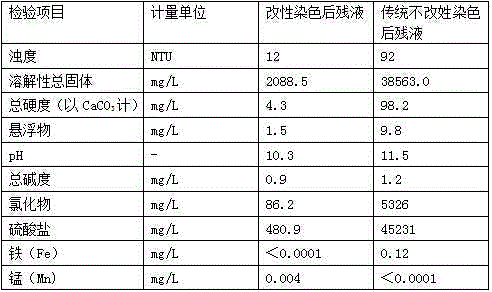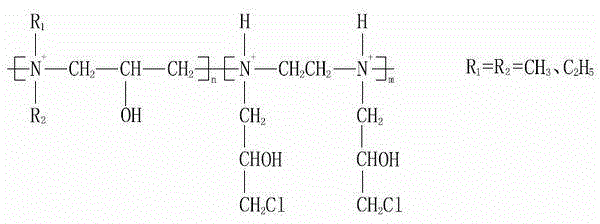Modification process for cellulosic fibers
A cellulose fiber and modification technology, which is applied in the field of textile dyeing, can solve the problems of not being suitable for large-scale production, high chromaticity of dyeing residue, and difficult to treat wastewater, and achieves high production efficiency, good cationization effect, and dye dosage. reduced effect
- Summary
- Abstract
- Description
- Claims
- Application Information
AI Technical Summary
Problems solved by technology
Method used
Image
Examples
Embodiment 1
[0062] Modification process of cellulose fiber:
[0063] Put the cellulose fiber into the container, add water to the container, and then use two kinds of quaternary ammonium salt cationic modifiers, modifier A and modifier B, to modify the cellulose fiber, and obtain Modified cellulose fiber: the modifier A is a small-molecular quaternary ammonium salt cationic modifier, and the modifier B is a high-molecular quaternary ammonium salt cationic modifier.
[0064] The above-mentioned process is the cellulose fiber modification process of the present invention, and when the pH value is 6.5-8.5, the Zeta electrode potential value is -10-30mV to obtain the modified cellulose fiber. Due to the small molecular weight of the small molecular quaternary ammonium salt cationic modifier, it can not only be adsorbed on the surface of the fiber but also diffuse into the fiber, while the high molecular weight quaternary ammonium salt cationic modifier has a large molecular weight, mainly ads...
Embodiment 2
[0066] Modification process of cellulose fiber:
[0067] Put the cellulose fiber into the container, add water to the container, and then use two kinds of quaternary ammonium salt cationic modifiers, modifier A and modifier B, to modify the cellulose fiber, and obtain Modified cellulose fiber: the modifier A is a small-molecular quaternary ammonium salt cationic modifier, and the modifier B is a high-molecular quaternary ammonium salt cationic modifier.
[0068] The cellulose fibers are selected from viscose filaments, viscose staple fibers, modal, tencel, cotton fibers, yarns and fabrics made from the aforementioned cellulose fibers.
[0069] The modification process of the present invention is applicable to all kinds of cellulose fibers, and also includes twisted yarns (hank form or cheese form) of these cellulose fibers, or fabrics (cloths, etc.) made of these cellulose fibers.
Embodiment 3
[0071] Modification process of cellulose fiber:
[0072] Put the cellulose fiber into the container, add water to the container, and then use two kinds of quaternary ammonium salt cationic modifiers, modifier A and modifier B, to modify the cellulose fiber, and obtain Modified cellulose fiber: the modifier A is a small-molecular quaternary ammonium salt cationic modifier, and the modifier B is a high-molecular quaternary ammonium salt cationic modifier.
[0073] Among them, the small molecule quaternary ammonium salt cationic modifier is selected from epoxy quaternary ammonium salt compound, epichlorohydrin parent derivative of epoxy quaternary ammonium salt, 3-acrylamide-2-hydroxypropyl trimethyl ammonium chloride, aza Cyclobutane chloride or chlorotriazine type quaternary ammonium compounds.
[0074] Among them, the polymer quaternary ammonium salt cationic modifier is selected from polyepichlorohydrin dimethylamine, polyamide polyamine epichlorohydrin, cationic polyacrylam...
PUM
| Property | Measurement | Unit |
|---|---|---|
| electric potential / voltage | aaaaa | aaaaa |
Abstract
Description
Claims
Application Information
 Login to View More
Login to View More - R&D
- Intellectual Property
- Life Sciences
- Materials
- Tech Scout
- Unparalleled Data Quality
- Higher Quality Content
- 60% Fewer Hallucinations
Browse by: Latest US Patents, China's latest patents, Technical Efficacy Thesaurus, Application Domain, Technology Topic, Popular Technical Reports.
© 2025 PatSnap. All rights reserved.Legal|Privacy policy|Modern Slavery Act Transparency Statement|Sitemap|About US| Contact US: help@patsnap.com



